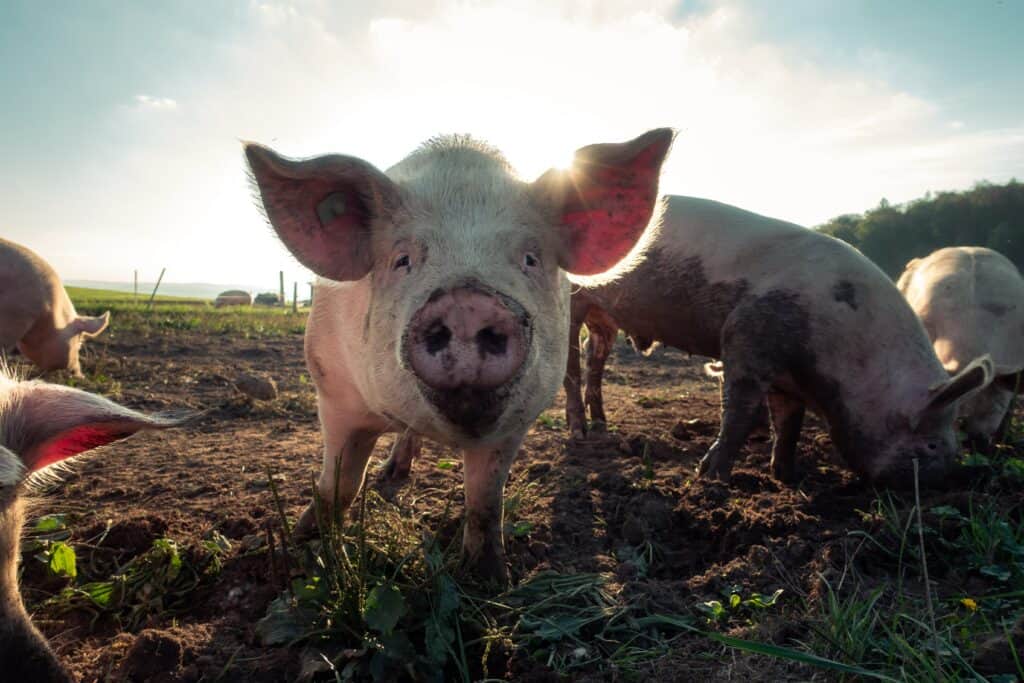How much do you really know about pigs?
Probably not much. But pigs are one of the most fascinating animals on the farm. They’re smart, funny, and when they feel like it, they can run surprisingly fast!
Here are 12 fun facts about pigs that you may not know…and one or two that you definitely don’t know!
PS…come out to the Barton Hill Farms 2022 Fall Festival on the weekends of October 29th – 30th and November 5th – 6th for a treat! Swifty Swine’s Racing Pigs will be at the farm with their pack of precious piglets. They’ll race on their cute little legs to see who’s the swiftest swine of all.
Types of Pigs…And How They Got Here
There Are Hundreds of Breeds of Pigs Worldwide!
Wild pigs and boars originated in Eurasia and Northern Africa, but they’re now found on every continent except Antarctica.
There are hundreds of breeds of wild and domestic pigs in the world. In the United States, there are eight major breeds of domesticated swine:
- American Yorkshire
- Chester White
- Choctaw Hog
- Duroc (this is the breed we have at Barton Hill Farms!)
- Guinea Hog
- Hereford
- Poland China
- Red Wattle Hog
Yorkshires are the most common, and they’re the pigs that you probably envision—pinkish white with erect ears and long bodies.
European Settlers Brought Pigs to America
The first domesticated pigs were introduced to the United States by Christopher Columbus in 1493. 35 years later, the Spanish explorer Hernando DeSoto also brought hogs to the New World—by some estimates as many as 300! Over time, domesticated pigs escaped their enclosures and established wild pig populations across the continent.
Today, the greatest concentrations of wild pigs in the U.S. are in Texas, Oklahoma, Louisiana, Arkansas, Georgia, Alabama, Mississippi, Florida, and California.
The Long and Short of Pigs
Pigs Can Be Tiny or HUGE!
The average weight of domestic pigs is between 300 and 700 pounds, although certain breeds can weigh less or more.
The largest wild pig is the giant forest hog, which can grow up to 6.6 feet long. And the heaviest is the Eurasian wild pig, which can reach a whopping 710 pounds.
On the other side of the scale, the cute pygmy hog usually weighs less than 21 lbs and stands under 10” tall at the shoulder.
The Biggest Domestic Pig Weighed Over a Ton
Big Bill was the largest pig ever on record. He was a Poland China breed who stood 5 feet tall and weighed 2,552 pounds.
Big Bill has held the record since 1933! In the 89 years since, no one has been able to outweigh this porker.

Pig Behaviors
Pigs Like to Keep Clean
Pigs have a reputation for being dirty animals, but they actually like to be clean! Their bad rep comes from the fact that like dogs, pigs can’t sweat to cool off. So in warm temperatures, they like to roll around in the mud to cool their skin.
But as long as they’re not overheated, pigs actually keep very clean. In fact, they are careful not to leave their waste anywhere near where they eat or sleep.
Pigs Can Communicate
Those squeaks and grunts aren’t just noise. They’re actually a way for pigs to communicate with each other and express their moods. They may grunt to warn other pigs of approaching danger, or make unique sounds when running, waiting, or fighting.
Pigs Can Run Faster Than Most People!
We don’t think of pigs as being very speedy. But domestic pigs can actually run as fast as 11 miles per hour, and wild boars can run even faster at 15 miles per hour. This is how they escape predators in the wild.
How Pigs Work
Pigs Can Breathe Through Their Butts
It’s TRUE. Pigs, rats, and mice can all absorb oxygen through their intestines.
Why do we know this, you might ask? During the COVID-19 pandemic, traditional ventilators were in short supply. So researchers wanted to figure out if it was possible to get oxygen into sick people another way. Inspired by aquatic animals that can absorb oxygen through their intestines, they performed studies on rats, mice, and pigs to see if it could be done…and it can!
Pigs Are Opportunistic Eaters
Domestic pigs are fed a diet of corn, wheat, soy, and/or barley. But in the wild, boars will eat whatever they can find. They mostly survive on roots, bulbs, seeds, and plants, but they’ll eat small mammals and even carrion if they can find it.
Momma Pigs Carry Big Litters
A sow usually carries 10 or more piglets at a time. Some have even had over 20 piglets in a single litter! Domestic pigs usually carry more piglets at once than wild boars.
Pigs are pregnant for three months, three weeks, and three days—that’s about 114 days total.
About Piglets
Baby pigs are called piglets. They weigh about 2.5 lbs when they’re born, and they’ll double their weight within the first week.
Newborn piglets can recognize their mother’s voices, and they’ll run to her when she calls.
A Pig’s Best Sense Is In Its Snout
Pigs don’t have great vision, but they make up for it with an impressive sense of smell. In the wild, they use their snouts to sniff out tasty tubers and roots on the forest floor.
They smell so well that some truffle hunters bring pigs with them to help them root out the valuable (and delicious) fungi.

